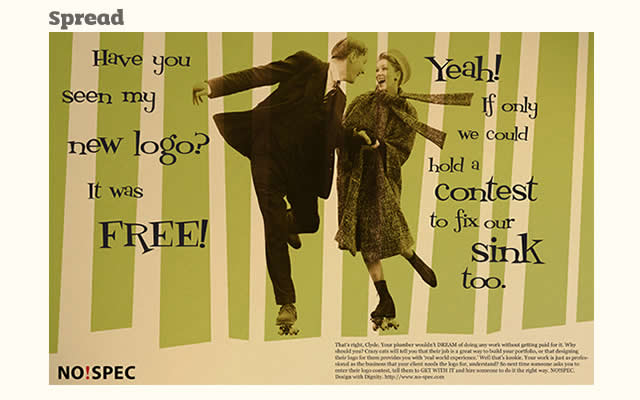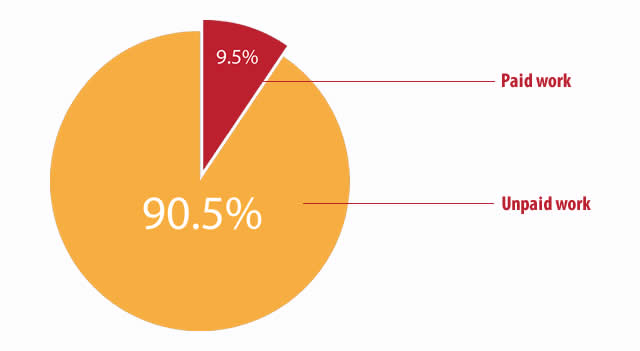Speculative, or ‘Spec”’, work is in hot debate at the moment in the design industry. Design contest websites in particular have created a furore of debate over freelancers working initially for nothing, instead hoping that a client likes their work enough to want to pay for it.
Speculative work is where you agree a price, but the client pays in full upon acceptance of the work. In other words it is where you submit full completed work before you have taken any form of payment, or signed a binding contract.
My Story
Let us be clear that spec work is not just about design contest websites. Back when I worked freelance after graduating from University, I began plying for work on community websites. The kind of people that got back to me would list their demands.
I would inform them on the likely cost and then I would begin working. Naturally, it just so flowed that I would then show them how I was getting on.
This was a big mistake because inevitably they would want changes, or worse, want me to start again. And of course, when this happened, nothing was said about the cost.

Unfortunately, design work suffers because the quality of the work is much down to interpretation. Everybody has their own opinions on whether a logo, website, etc is good or not.
Whereas when you call in a plumber, you don’t question their techniques and the end result is irrelevant – it either works or it doesn’t, there is little or no degree of interpretation.
So of course, what kept happening to me is I would spend dozens of hours on work only to find myself unpaid. I even built a fully functioning e-commerce site for a client who decided she didn’t like it after a whole month of work.
Why is Spec work bad?
Apart from the point above, that you may find yourself unpaid, there are other issues that bring a negative feeling to spec work.
Designers
Competition.
With design contest websites you are competing with hundreds of other designers. So you could spend a lot of time creating design work for absolutely nothing.
Even if you do win, the fees are small.
99designs pays as little as $100 for a logo. That’s if you win. This also has another side effect in that it creates unrealistic expectations of how much design work costs, which could have a negative impact on all of us, not just those of us that use contest sites.
Design contest websites claim they benefit designers by adding to your portfolio and giving you recognition.
But are you willing to work, more than likely for nothing, for the sake of recognition? Even so, it’s debatable if contest work will actually help you.
Your quality of work will suffer.
Naturally, we don’t care so much about work if we’re not getting paid for it. Invariably, if you submit entries to a contest site they will more than likely not be as good as work you do when you have been paid a fee up front.

Clients
From a clients point of view, it would be extremely frustrating if we paid £500 for a logo yet the end result was nothing close to what we wanted and we ended up not even using it. Imagine having to repeat this process several times until you got the logo you wanted, it could end up costing thousands. However, even from a client’s point of view, speculative work should be avoided and the results may not match the temptations of the low costs.
Low quality work.
Because there is little chance of designers winning, most who submit work spend little time on it and it is usually of a low quality, clip art is prevalent. If you are serious about the brand identity of your company, a design agency or professional individual designer is the sensible choice.
Anonymity of designers.
Would you open your front door to a decorator in a balaclava? Allowing someone who you do not know and have little or no idea about where they are from or who they are to brand your company or build your website is foolishness, for the same reasons you wouldn’t let someone else you don’t know to tamper with any other aspect of your business.
Design contests essentially promote free labour.
You wouldn’t call over 10 plumbers to fix your toilet and only pay one of them – so why should this be any different? Simple – it shouldn’t.
Plagiarism.
Plagiarism is nothing short of rife on design contest sites. You may think you are getting an original logo, but where did that clip art come from? Is the font licensed? The logo a client gets may not be legitimate, it may even be illegal.
What should I do instead?
First of all, every freelancer should have a rough pricing structure. My advice would be if freelance is really the way you want to go, invest some time working out how much you feel you should be paid for work. Your pricing structure doesn’t need to be rigid, in fact it should be flexible, but it is essential you know your worth before you do any work.
Remember, don’t undervalue yourself, you are charging people not just for your time, but your expertise. Don’t forget to make it clear what happens when the client asks for revisions.
Secondly, get everything in writing and agreed and signed for before you commence a project. Inform your prospective client of all the costs, and explain them. You should also explain to the client that if you are working by the hour, actual costs may vary. If they want to spend a fixed amount, agree a fixed fee for a fixed number of hours of your time.
If you have to go over these hours, charge for them but liaise with the client first. The best thing to do is to get everything written in a legally binding contract which the client signs. They are then obligated to pay you, providing you complete the work.
If you are a client and you don’t want to be a position whereby you have paid for unsatisfactory work, the best practice is to go to a reputable design company or freelancer.
Be as helpful to the designer as possible, make it clear what the ethos of your business is and try and be clear in your demands – don’t contradict yourself, it’s very frustrating when clients ask for a minimal design but then ask for a floral background.
If you are a designer just starting out, you may have to find yourself charging smaller fees for your work and plying for jobs on community boards such as Gumtree and Craigslist. This isn’t necessarily bad but there are other ways.
I have found being a member of Concept Feedback highly beneficial – at first the work I submitted was just for fun but as I became a member of the community I actually was approached for work by people who had seen my designs on the site.
Additionally, the feedback I got has improved me as a designer hugely. Be proactive, make business cards and flyers and promote yourself locally.
And lastly, one key tip which I think is worth mentioning is the relationship between client and designer is usually several times better when you know them in person. Don’t be afraid as a designer to meet your client.
If you have to travel for an hour on a train just for a coffee – so be it. It will also portray you in a good light because it shows you care about the work.
If you have anything to add about spec work or would like to share your own experiences or thoughts, I would love to hear from you.
Related Topics
Top